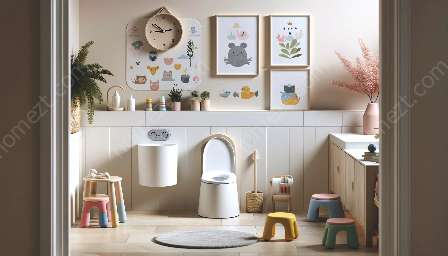Potty training is a significant milestone in a child's development, and recognizing the signs of readiness is crucial for a successful transition. This guide will provide you with valuable insights into identifying when your child is ready for potty training and how to prepare their nursery and playroom for this exciting journey.
Understanding the Signs of Readiness
Every child is unique, and readiness for potty training can vary. However, there are common signs that indicate your child may be prepared for this developmental stage:
- Showing Interest: If your child starts showing curiosity about using the toilet or imitates family members during bathroom visits, it could be a sign of readiness.
- Ability to Communicate: Being able to communicate their need to use the toilet, whether through words, gestures, or expressions, is an essential indicator of readiness.
- Physical Readiness: Your child may start demonstrating bladder and bowel control, staying dry for extended periods or showing discomfort in a soiled diaper.
- Independence: Expressing a desire to do things independently, such as pulling down pants or wanting privacy during diaper changes, suggests readiness for potty training.
Preparing the Nursery and Playroom
Creating an environment that supports and encourages potty training is essential for a smooth transition. Here are some tips to prepare your child's nursery and playroom for the potty training journey:
1. Introduce Potty Training Tools
Start by introducing a child-friendly potty chair or seat in the bathroom. Additionally, consider having a step stool to help your child reach the sink and a basket of clean underwear within easy reach.
2. Use Visual Cues
Implement visual cues, such as posters or pictures, that illustrate the steps of using the toilet. This can help your child understand and remember the process more effectively.
3. Keep It Accessible and Familiar
Ensure that the bathroom and playroom are easily accessible to your child. Familiarize them with the bathroom environment and encourage them to visit frequently to create a sense of comfort and routine.
4. Encourage Independence
Provide opportunities for your child to practice independent toilet use. Dressing them in clothes that are easy to remove and teaching them to wipe and wash their hands independently will foster a sense of ownership over the process.
Tips for a Successful Potty Training Experience
As you embark on the potty training journey, keep these helpful tips in mind:
1. Patience and Encouragement
Be patient and provide plenty of positive reinforcement. Celebrate small victories and offer encouragement, making the experience a positive and rewarding one for your child.
2. Consistency Is Key
Consistent routines and reminders play a vital role in successful potty training. Establish regular bathroom breaks and encourage your child to use the potty at specific times throughout the day.
3. Understand Accidents
Accidents are a natural part of the learning process. Instead of scolding or shaming, offer reassurance and guide your child through the cleanup process, emphasizing that it's okay to make mistakes.
4. Celebrate Milestones
Mark significant achievements, such as using the potty for the first time or staying dry throughout the day, with praise, rewards, or a special celebration. This will motivate your child and reinforce positive behavior.
In Conclusion
Recognizing the signs of readiness for potty training and creating a supportive environment in the nursery and playroom are essential steps for a successful transition. By understanding your child's cues, preparing the right environment, and approaching the journey with patience and positivity, you can make the potty training experience a rewarding and memorable milestone for both you and your child.


